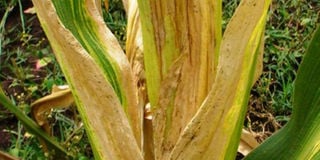East African scientists in fight to combat maize lethal necrosis

When infected by Maize Lethal Necrosis Disease, the crop does not flower or bear cobs but rather dries up and dies. PHOTO BY Naccri
What you need to know:
East African scientists are pooling resources, knowledge and skills to combat the rapidly spreading Maize Lethal Necrosis Disease (MLND), a viral infection in maize, a staple food crop in the region.
The strategy is coordinated by International Centre for Wheat and Maize Improvement (CIMMYT), and a screening facility was established at Naivasha, Kenya, in 2013. CIMMYT and Kenya Agricultural Research Institute have been conducting trials since 2012 to identify lines and hybrids with resistance to MLND. Scientists from Tanzania and Uganda also participated in the field evaluations.
Dr Godfrey Asea, who participated, reveals that there are promising results. “The good news that emerged in Naivasha is that the in-bred and hybrid maize lines are showing promise due to their high level of tolerance,” he explains. “They yield good amounts inspite of a high infestation. This is unlike the varieties currently grown throughout East Africa, which are neither tolerant nor resistant. They all succumb to MLND.”
MLND, which wipes out the crop, is caused by double infection with maize chlorotic mottle virus (MCMV) and any cereal viruses such as sugarcane mosaic virus (SCMV), maize dwarf mosaic virus (MDMV), or wheat streak mosaic virus (WSMV).
“MCMV or SCMV typically produce milder symptoms when they infect maize alone. But, in combination, the two viruses rapidly produce a reaction that seriously damages and kills maize plants,” observes Asea, who heads cereals research at National Crops Resources Research Institute (NaCRRI) at Namulonge.
The promising lines will act as a bridge-gap towards getting resistant lines, which will be products of a longer-term research work.
“One of the key actions we agreed upon, is to establish satellite centres in Uganda and Tanzania for the evaluation and validation of the tolerant maize lines,” says Asea, adding that resistant lines will be the best solution.
MLND is largely confined to the eastern region, but there have been isolated outbreaks in Kasese (western) and Mukono (central region).
Reports by CIMMYT show that MLND is a serious concern in Kenya, Tanzania, Uganda and possibly Rwanda, and that they have been working with other partners to combat the disease through host-controlled resistance.
Key interest groups such as Uganda Grain Council and Uganda Seed Trade Association have issued calls to scientists to develop MLND-resistant varieties to save the high-value food and cash-crop.
Uganda produces over 2.5 million metric tonnes of maize and sells close to $28m (Shs70bn) worth of exports, according to 2013 Bank of Uganda figures.
about maize lethal necrosis
What are the typical symptoms?
• Mild to severe mottling on the leaves, usually starting from the base of young leaves in the whorl and extending upwards toward the leaf tips.
• Stunting and premature aging of the plants.
• Dying (known as “necrosis”) of the leaf margins that progresses to the mid-rib and eventually the entire leaf.
• Necrosis of young leaves in the whorl before expansion, leading to a symptom known as “dead heart” and eventually plant death.
How can it be controlled?
Based on experiences elsewhere, rigorous disease management practices in seed production plots, including use of resistant varieties, controlling weeds/alternate hosts, keeping unnecessary machines/people out of the field, controlling insect-vectors using appropriate insecticide (at weekly intervals), and having adequate isolation from infected fields, can prevent the spread of the disease.
How can farmers prevent the disease?
• Maize Lethal Necrosis does not occur on other crops, so avoid growing maize after maize. Diversify by planting different crops each season. A break interrupts the disease cycle.
• Do not plant a new maize crop near an infected field. Wind-blown insect vectors can transmit the disease.
• Plant maize at the onset of the main rainy season, rather than during the short rain season. Early planted maize are known to escape the disease before it reaches peak epidemic situations
• Weed fields regularly to eliminate alternate hosts for insect vectors.
• Use resistant maize varieties.
What should farmers do?
• Immediately remove diseased plants from the field. You can feed the leaves to livestock.
• Do not allow humans or animals to eat infected ears or grains, which may contain secondary fungal infections and harmful mycotoxins.
• Burn infected ears and grains.




